上海交通大学:《材料热力学 Thermodynamics of materials》课程教学资源(课件讲稿)lecture 3 第二定律 Second law(1/2)

Contents of Today S.J.T.0. Phase Transformation and Applications Continue /Review previous 2nd law Entropy Reversible process Carnot cycle etc. SJTU Thermodynamics of Materials Spring2o08©X.J.Jin Lecture 3 Second law I
Phase Transformation and Applications S. J. T. U. SJTU Thermodynamics of Materials Spring 2008 © X. J. Jin Lecture 3 Second law I Contents of Today Continue / Review previous 2nd law Entropy Reversible process Carnot cycle etc
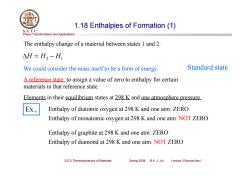
1.18 Enthalpies of Formation(1) S.J.T.0. Phase Transformation and Applications The enthalpy change of a material between states 1 and 2: △H=H2-H1 We could consider the mass itself to be a form of energy. Standard state A reference state:to assign a value of zero to enthalpy for certain materials in that reference state. Elements in their equilibrium states at 298 K and one atmosphere pressure. Ex., Enthalpy of diatomic oxygen at 298 K and one atm:ZERO Enthalpy of monatomic oxygen at 298 K and one atm:NOT ZERO Enthalpy of graphite at 298 K and one atm:ZERO Enthalpy of diamond at 298 K and one atm:NOT ZERO SJTU Thermodynamics of Materials Spring2008©X.J.Jin Lecture 3 Second law I
Phase Transformation and Applications S. J. T. U. SJTU Thermodynamics of Materials Spring 2008 © X. J. Jin Lecture 3 Second law I 1.18 Enthalpies of Formation (1) The enthalpy change of a material between states 1 and 2: H H2 H1 We could consider the mass itself to be a form of energy. A reference state: to assign a value of zero to enthalpy for certain materials in that reference state. Elements in their equilibrium states at 298 K and one atmosphere pressure. Ex., Enthalpy of diatomic oxygen at 298 K and one atm: ZERO Enthalpy of monatomic oxygen at 298 K and one atm: NOT ZERO Enthalpy of graphite at 298 K and one atm: ZERO Enthalpy of diamond at 298 K and one atm: NOT ZERO Standard state

1.19 Enthalpy Change in Chemical Reactions(2) S.J.T.0. Phase Transformation and Applications In general,the enthalpy change for a chemical reaction at a specified temperature may be expressed as the sum of the enthalpies of formation of the products less the enthalpies of formation of the reactions at that temperature. △H=∑n,AHI-∑n,AH.T products reactants where np and n,are the stoichiometric coefficients of the reaction. Enthalpy of combusion the enthalpy change for methane when it is reacted with oxygen,or the heat of combustion of methane. Low heat of combustion:gas water;High heat of combustion:liquid water. SJTU Thermodynamics of Materials Spring 2008 ©X.J.Jin Lecture 3 Second law I
Phase Transformation and Applications S. J. T. U. SJTU Thermodynamics of Materials Spring 2008 © X. J. Jin Lecture 3 Second law I 1.19 Enthalpy Change in Chemical Reactions (2) reac ts r f T products HT np H f T n H tan , , i. e., In general, the enthalpy change for a chemical reaction at a specified temperature may be expressed as the sum of the enthalpies of formation of the products less the enthalpies of formation of the reactions at that temperature. where np and nr are the stoichiometric coefficients of the reaction. Enthalpy of combusion : the enthalpy change for methane when it is reacted with oxygen, or the heat of combustion of methane. Low heat of combustion: gas water; High heat of combustion: liquid water
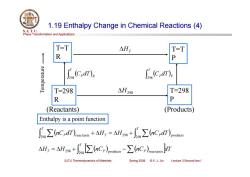
1.19 Enthalpy Change in Chemical Reactions (4) S.J.T.0. Phase Transformation and Applications T-T △HT T-T R 3mjeladwaL .(C). 以c,ar) T=298 △H298 T=298 R P Reactants (Products) Enthalpy is a point function ∑(nCrdT))ncma+AH,=AHw+f∑6 nCndT)p AH,=AHs+g∑Cr-∑6nCr)rmrr SJTU Thermodynamics of Materials Spring 2008 ©X.J.Jin Lecture 3 Second law I
Phase Transformation and Applications S. J. T. U. SJTU Thermodynamics of Materials Spring 2008 © X. J. Jin Lecture 3 Second law I 1.19 Enthalpy Change in Chemical Reactions (4) T=T R T=298 R T=T P T=298 P H298 HT T P R C dT 298 T P P C dT 298 Temperature (Reactants) (Products) Enthalpy is a point function T T P products T P reac ts nC dT H H nC dT 298 298 298 tan H H nC nC dT T T P products P reac ts 298 298 tan

1.20 Adiabatic Temperature Change in Chemical Reactions(1) S.J.T.0. Phase Transformation and Applications Adiabatic flame temperature Fuel gas 20% Carbon monoxide (CO) 30% Carbon dioxide (CO2) 50% C0+20,→c0, Nitrogen (N2) 2 Gas Moles in Moles out Exit gas composition (% co 0.20 0 C02 0.30 0.50 36 02 0.10 0 N2 0.5+0.1×(79/21) 0.88 64 Total 1.38 100 SJTU Thermodynamics of Materials Spring2008©X.J.Jin Lecture 3 Second law I
Phase Transformation and Applications S. J. T. U. SJTU Thermodynamics of Materials Spring 2008 © X. J. Jin Lecture 3 Second law I 1.20 Adiabatic Temperature Change in Chemical Reactions (1) Adiabatic flame temperature Gas Moles in Moles out Exit gas composition (%) CO 0.20 0 CO2 0.30 0.50 36 O2 0.10 0 N2 0.5+0.1(79/21) 0.88 64 Total 1.38 100 Fuel gas 20 % Carbon monoxide (CO) 30 % Carbon dioxide (CO2) 50 % Nitrogen (N2) 2 2 2 1 CO O CO
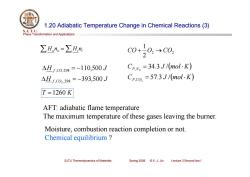
1.20 Adiabatic Temperature Change in Chemical Reactions(3) S.J.T.0. Phase Transformation and Applications ∑H。n,=∑Hn 0+0→c0, △H/.c0.298=-110,500J Cp.N:=34.3 J/(mol.K) △Hf,c0,298=-393,500J Cp.co.=57.3 J/(mol.K) T=1260K AFT:adiabatic flame temperature The maximum temperature of these gases leaving the burner. Moisture,combustion reaction completion or not. Chemical equilibrium SJTU Thermodynamics of Materials Spring2o08©X.J.Jin Lecture 3 Second law I
Phase Transformation and Applications S. J. T. U. SJTU Thermodynamics of Materials Spring 2008 © X. J. Jin Lecture 3 Second law I 1.20 Adiabatic Temperature Change in Chemical Reactions (3) Hono Hini 2 2 21 CO O CO H J f ,CO,298 110,500 H J f ,CO ,298 393,500 2 C J mol K P N 34.3 / 2 , C J mol K P CO 57.3 / 2 , T 1260 K AFT: adiabatic flame temperature The maximum temperature of these gases leaving the burner. Moisture, combustion reaction completion or not. Chemical equilibrium ?

Review Key points S.J.T.0. Phase Transformation and Applications 1.Adiabatic process:Joule-Thomson expansion 2.Equations of state 3.Adiabatic compression or expansion 4.Enthalpies of formation 5.Enthalpy changes in chemical reactions 6.Adiabatic temperature change in chemical reactions SJTU Thermodynamics of Materials Spring2o08©X.J.Jin Lecture 3 Second law I
Phase Transformation and Applications S. J. T. U. SJTU Thermodynamics of Materials Spring 2008 © X. J. Jin Lecture 3 Second law I Review / Key points 1. Adiabatic process: Joule-Thomson expansion 2. Equations of state 3. Adiabatic compression or expansion 4. Enthalpies of formation 5. Enthalpy changes in chemical reactions 6. Adiabatic temperature change in chemical reactions

1.17 Adiabatic Compression or Expansion(1) S.J.T.0. Phase Transformation and Applications Air arises rapidly (adiabatically)up a mountainside. At the higher altitude,the pressure is lower,and the temperature is also lower. Adiabatic Reversible:Presisting=Psystem Ideal gas System boundary 0+=dU Pdv dU =nCrdT P ystem Presisting PV=nRT Pav+Vdp nRdT 绝热压缩和膨胀 SJTU Thermodynamics of Materials Spring2008©X.J.Jin Lecture 3 Second law I
Phase Transformation and Applications S. J. T. U. SJTU Thermodynamics of Materials Spring 2008 © X. J. Jin Lecture 3 Second law I 1.17 Adiabatic Compression or Expansion (1) Air arises rapidly (adiabatically) up a mountainside. At the higher altitude, the pressure is lower, and the temperature is also lower. Presisting System boundary Psystem Adiabatic Reversible: Presisting=Psystem Ideal gas Q W dU PdV dU nCV dT PdV VdP nRdT PV nRT 绝热压缩和膨胀
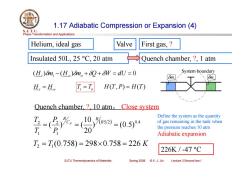
1.17 Adiabatic Compression or Expansion (4) s.J.T.0. Phase Transformation and Applications Helium,ideal gas Valve First gas,.? Insulated 50L,25 C.20 atm Quench chamber,?1 atm (L,),-(H。)6im。+8Q+8w=dU=0 System boundary om m。 H,=H。 T=T, H(T,P)=H(T) Quench chamber.?10 atm,Close system Define the system as the quantity of gas remaining in the tank when the pressure reaches 10 atm Adiabatic expansion T3=T(0.758)=298×0.758=226K 226K/-47°C SJTU Thermodynamics of Materials Spring 2008 ©X.J.Jin Lecture 3 Second law I
Phase Transformation and Applications S. J. T. U. SJTU Thermodynamics of Materials Spring 2008 © X. J. Jin Lecture 3 Second law I 1.17 Adiabatic Compression or Expansion (4) Helium, ideal gas Insulated 50L, 25 C, 20 atm Quench chamber, ?, 1 atm (H ) m (H ) m Q W dU 0 i i o o Valve H i H o 5 2 0.4 1 2 1 2 ) (0.5) 2010 ( ) ( R R CR P PP TT T2 T1(0.758) 2980.758 226 K 226K / -47 C System boundary mi mo First gas, ? Ti To Quench chamber, ?, 10 atm, Close system H(T, P) H(T) Define the system as the quantity of gas remaining in the tank when the pressure reaches 10 atm Adiabatic expansion
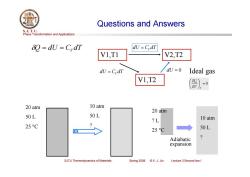
Questions and Answers S.J.T.0. Phase Transformation and Applications 80=dU=CvdT dU=CdT V1,T1 V2,T2 d CdT dU =0 Ideal gas V1,T2 =0 20 atm 10 atm 20 atm 50L 50L ?L 10 atm 25C 25℃ 50L Adiabatic ? expansion SJTU Thermodynamics of Materials Spring 2008 ©X.J.Jin Lecture 3 Second law I
Phase Transformation and Applications S. J. T. U. SJTU Thermodynamics of Materials Spring 2008 © X. J. Jin Lecture 3 Second law I Questions and Answers V1,T1 V2,T2 V1,T2 dU 0 Ideal gas 0 V T U dU CV dT Q dU C dT dU CV dT V 20 atm 50 L 25 C 10 atm 50 L ? 10 atm 50 L ? 20 atm ? L 25 C Adiabatic expansion
按次数下载不扣除下载券;
注册用户24小时内重复下载只扣除一次;
顺序:VIP每日次数-->可用次数-->下载券;
- 上海交通大学:《材料热力学 Thermodynamics of materials》课程教学资源(课件讲稿)lecture 2 第一定律 First law(2/2).pdf
- 上海交通大学:《材料热力学 Thermodynamics of materials》课程教学资源(课件讲稿)lecture 1 第一定律 First law(1/2).pdf
- 上海交通大学:《材料加工原理 Principles of Materials Processing》教学资源(课程讲稿)金属材料热处理原理 Heat Treatment Principles of Metals Chapter 11 Precipitation transformations.pdf
- 上海交通大学:《材料加工原理 Principles of Materials Processing》教学资源(课程讲稿)金属材料热处理原理 Heat Treatment Principles of Metals Chapter 10 Shear Transformation.pdf
- 上海交通大学:《材料加工原理 Principles of Materials Processing》教学资源(课程讲稿)金属材料热处理原理 Heat Treatment Principles of Metals Lecturer:Ke Chen Chapter 9 Eutectoid and Reverse Eutectoid.pdf
- 上海交通大学:《材料加工原理 Principles of Materials Processing》教学资源(课程讲稿)金属材料热处理原理 Heat Treatment Principles of Metals Chapter 9 Eutectoid and Reverse Eutectoid.pdf
- 上海交通大学:《材料加工原理 Principles of Materials Processing》教学资源(课程讲稿)金属材料热处理原理 Heat Treatment Principles of Metals Chapter 9 Eutectoid and Reverse Eutectoid.pdf
- 上海交通大学:《材料加工原理 Principles of Materials Processing》教学资源(课程讲稿)金属材料热处理原理 Heat Treatment Principles of Metals Chapter 9 Eutectoid and Reverse Eutectoid.pdf
- 上海交通大学:《材料加工原理 Principles of Materials Processing》教学资源(课程讲稿)金属材料热处理原理 Heat Treatment Principles of Metals Chapter 8 Intro to Phase Transformation in Solids.pdf
- 上海交通大学:《材料加工原理 Principles of Materials Processing》教学资源(课程讲稿)金属材料热处理原理 Heat Treatment Principles of Metals Chapter 8 Intro to Phase Transformation in Solids.pdf
- 《材料加工原理 Principles of Materials Processing》课程教学资源(书籍文献)《RECRYSTALLIZATION AND RELATED ANNEALING PHENOMENA》(SECOND EDITION).pdf
- 《材料加工原理 Principles of Materials Processing》课程教学资源(书籍文献)《Metal Forming Mechanics and Metallurgy》William F. Hosford and Robert M(FOURTH EDITION).pdf
- 《材料加工原理 Principles of Materials Processing》课程教学资源(书籍文献)《Mechanical Metallurgy》(Dieter 1988,SI Metric Edition).pdf
- 上海交通大学:《材料加工原理 Principles of Materials Processing》教学资源(课程讲稿)05. Technology of plasticity——Recovery & recrystallization.pdf
- 上海交通大学:《材料加工原理 Principles of Materials Processing》教学资源(课程讲稿)04. Technology of plasticity——plastic deformation mechanism.pdf
- 上海交通大学:《材料加工原理 Principles of Materials Processing》教学资源(课程讲稿)03. Technology of plasticity——Elements of plastic theory.pdf
- 上海交通大学:《材料加工原理 Principles of Materials Processing》教学资源(课程讲稿)02. Technology of plasticity——Processing maps.pdf
- 上海交通大学:《材料加工原理 Principles of Materials Processing》教学资源(课程讲稿)01. Technology of plasticity——Introduction.pdf
- 上海交通大学:《材料加工原理 Principles of Materials Processing》教学资源(课件讲稿)凝固和铸造 Solidification and casting_Metal Casting Technology(3).pdf
- 上海交通大学:《材料加工原理 Principles of Materials Processing》教学资源(课件讲稿)凝固和铸造 Solidification and casting_Metal Casting Technology(2).pdf
- 上海交通大学:《材料热力学 Thermodynamics of materials》课程教学资源(课件讲稿)lecture 4 第二定律 Second law(2/2).pdf
- 上海交通大学:《材料热力学 Thermodynamics of materials》课程教学资源(课件讲稿)lecture 5 property relation(1/2).pdf
- 上海交通大学:《材料热力学 Thermodynamics of materials》课程教学资源(课件讲稿)lecture 6 property relation(2/2).pdf
- 上海交通大学:《材料热力学 Thermodynamics of materials》课程教学资源(课件讲稿)lecture 7 equilibrium.pdf
- 上海交通大学:《材料热力学 Thermodynamics of materials》课程教学资源(PPT课件讲稿)Chapter7 Solution(1/2).ppt
- 上海交通大学:《材料热力学 Thermodynamics of materials》课程教学资源(PPT课件讲稿)Chapter7 Solution(2/2).ppt
- 上海交通大学:《材料热力学 Thermodynamics of materials》课程教学资源(PPT课件讲稿)Chapter8 Phase Rule.ppt
- 上海交通大学:《材料热力学 Thermodynamics of materials》课程教学资源(PPT课件讲稿)Chapter9 Phase Diagram(1/3).ppt
- 上海交通大学:《材料热力学 Thermodynamics of materials》课程教学资源(PPT课件讲稿)Chapter9 Phase Diagram(3/3).ppt
- 上海交通大学:《材料热力学 Thermodynamics of materials》课程教学资源(PPT课件讲稿)Chapter9 Phase Diagram(3/3).ppt
- 上海交通大学:《材料热力学 Thermodynamics of materials》课程教学资源(PPT课件讲稿)Chapter 11 Surface and Interface(2016).ppt
- 上海交通大学:《材料热力学 Thermodynamics of materials》课程教学资源(PPT课件讲稿)Chapter 11 Surface and Interface(2016).ppt
- 上海交通大学:《材料热力学 Thermodynamics of materials》课程教学资源(实验)粉体材料比表面积的测定.docx
- 上海交通大学:《材料热力学 Thermodynamics of materials》课程教学资源(PPT课件讲稿)Chapter 11 Surface and Interface.ppt
- 上海交通大学:《材料热力学 Thermodynamics of materials》课程教学资源(课件讲稿)Chapter10 Statistical Thermodynamics.pdf
- 上海交通大学:《材料热力学 Thermodynamics of materials》课程教学资源(课件讲稿)Chapter7 Solution.pdf
- 上海交通大学:《材料热力学 Thermodynamics of materials》课程教学资源(课件讲稿)Chapter7 Solution.pdf
- 上海交通大学:《材料热力学 Thermodynamics of materials》课程教学资源(课件讲稿)Chapter8 Phase rule.pdf
- 上海交通大学:《材料热力学 Thermodynamics of materials》课程教学资源(课件讲稿)Chapter9 Phase Diagram(2013,1/2).pdf
- 上海交通大学:《材料热力学 Thermodynamics of materials》课程教学资源(课件讲稿)Chapter9 Phase Diagram(2015,1/3).pdf
